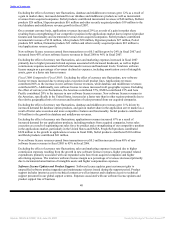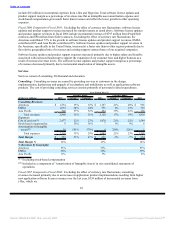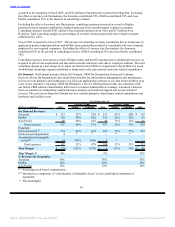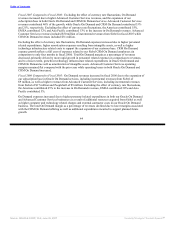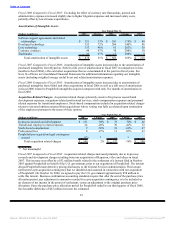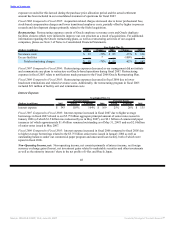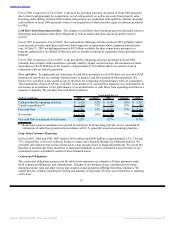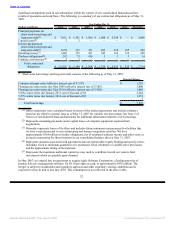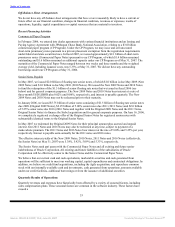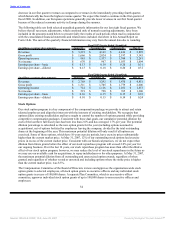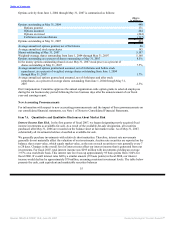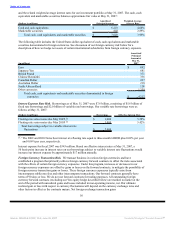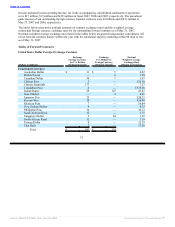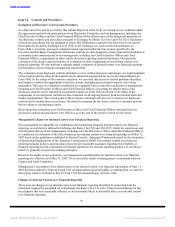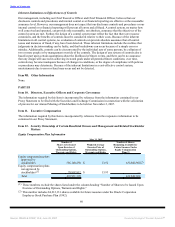Oracle 2006 Annual Report Download - page 54
Download and view the complete annual report
Please find page 54 of the 2006 Oracle annual report below. You can navigate through the pages in the report by either clicking on the pages listed below, or by using the keyword search tool below to find specific information within the annual report.
Table of Contents
Working capital: The decrease in working capital in fiscal 2007 was primarily a result of cash used to pay
for our acquisitions and stock repurchases, partially offset by increases in operating cash flows from higher
sales volumes, proceeds received from employee stock option exercises and an increase in our long-term
borrowings. The increase in working capital in fiscal 2006 is primarily due to our issuance of $5.75 billion
long-term senior notes in January 2006 as well as greater cash flows from operations from higher sales
volumes, partially offset by cash used to pay for acquisitions, stock repurchases, and the reduction of our
other debt obligations.
Cash, cash equivalents and marketable securities: Cash and cash equivalents consist of highly liquid
investments in time deposits held at major banks, commercial paper, United States government agency
discount notes, money market mutual funds and other money market securities with original maturities of
90 days or less. Marketable securities primarily consist of commercial paper, corporate notes and United
States government agency notes. Cash, cash equivalents and marketable securities include $5.0 billion held by
our foreign subsidiaries as of May 31, 2007. The decrease in cash, cash equivalents and marketable securities
is a result of cash used to pay for acquisitions and stock repurchases, partially offset by an increase in our
operating cash flows from higher sales volumes, increases in our short-term and long-term borrowings and
proceeds from stock option exercises.
Days sales outstanding, which is calculated by dividing period end accounts receivable by average daily sales
for the quarter, was 62 days at May 31, 2007 compared with 55 days at May 31, 2006. The days sales
outstanding calculation excludes the adjustment to reduce software license updates and product support
revenues related to adjusting the carrying value for deferred support revenues acquired to fair value. Our
increase in days sales outstanding is primarily due to higher days sales outstanding from acquired companies,
as well as differences in the timing of completion of certain sales transactions between years.
Year Ended May 31,
(Dollars in millions) 2007 Change 2006 Change 2005
Cash provided by operating activities $ 5,520 22% $ 4,541 28% $ 3,552
Cash used for investing activities $ (4,971) 48% $ (3,359) -42% $ (5,753)
Cash (used for) provided by financing
activities $ (1,139) -175% $ 1,527 -19% $ 1,884
Cash flows from operating activities: Our largest source of operating cash flows is cash collections from our
customers following the purchase and renewal of their software license updates and product support
agreements. Payments from customers for software license updates and product support agreements are
generally received by the beginning of the contract term, which is generally one year in length. We also
generate significant cash from new software license sales and, to a lesser extent, services. Our primary uses of
cash from operating activities are for personnel related expenditures as well as payments related to taxes and
facilities.
Fiscal 2007 Compared to Fiscal 2006: Cash flows provided by operating activities increased in fiscal 2007
primarily due to higher net income before non-cash charges, partially offset by increased accounts receivables
due to fourth quarter fiscal 2007 revenue growth, cash payments to terminate leases associated with excess
facilities assumed in the Siebel acquisition, an increase in cash interest payments resulting from higher
average borrowings and the settlement of a pre-acquisition lawsuit filed against PeopleSoft.
Fiscal 2006 Compared to Fiscal 2005: Cash flows provided by operating activities increased in fiscal 2006
primarily due to higher sales volumes and higher net income, excluding non-cash charges, partially offset by
increased accounts receivables due to fourth quarter fiscal 2006 revenue growth.
Cash flows from investing activities: The changes in cash flows from investing activities primarily relate to
acquisitions and the timing of purchases, maturities and sales of marketable securities. We also use cash to
invest in capital and other assets to support our growth.
Fiscal 2007 Compared to Fiscal 2006: Cash used for investing activities increased in fiscal 2007 due to an
increase in cash used for acquisitions, net of cash acquired. We paid cash to purchase a number of companies
in fiscal 2007 including Hyperion, Stellent, MetaSolv, and Portal Software, and to purchase additional equity
securities in i-flex. Cash outflows in fiscal 2006 primarily relate to our acquisition of Siebel and our equity
investment purchases in i-flex.
50
Source: ORACLE CORP, 10-K, June 29, 2007 Powered by Morningstar® Document Research℠


